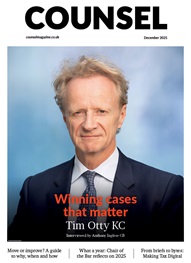*/
Lynne Townley and John Clifford take a look at how the sometimes competing concerns of public safety and open justice were met during previous pandemics
The so-called ‘Spanish flu’ of 1918-19 killed up to 50 million people. The first of the three waves hit Britain in May 1918 during the First World War. The press was highly censored, with information likely to negatively impact on morale or indicate weakness to the enemy strictly prohibited. A memorandum published by the Royal Society of Medicine in July 1918 advised people to stay at home and avoid large gatherings, but its author, Sir Arthur Newsholme, conceded that given the national circumstances, the major duty was to ‘carry on’ even when risk to life and public health were involved.
Then, like now, there were a number of contrary and confused public health messages. In a Commons debate, one MP asked whether cocoa taken three times a day could ward off the pandemic; others advocated eating large quantities of porridge; and some factories relaxed ‘no smoking’ rules due to a belief that cigarettes prevented infection. A newspaper cartoon advised that the only way to avoid Spanish flu was: ‘Don’t talk to anyone, don’t go near anyone!’
However, no centrally imposed lockdown was ever in place and, it appears, no consistent safety guidance for the operation of public services. Streets in some towns and cities were sprayed with disinfectant and some people wore anti-germ masks, but largely everyone appears to have just gone about their daily lives.
Many courts in this jurisdiction appeared to have carried on uninterrupted during 1918-19 – albeit criminal courts had to deal with some unusual behaviours and novel defences. While we have had many polite warnings during this pandemic about stockpiling food; it was an offence to do so back in 1918. A number of individuals were fined for hoarding large quantities of jam, which appeared to be a favourite item. Defence counsel for one Mr Goodwin told Birkenhead County Magistrates’ Court that his client ‘had been in the habit for some time past of getting a quantity of jam to last the family throughout the year’. Another defendant attempted to raise a novel defence to a charge of attempted theft of a motor vehicle, namely that he was suffering from the after-effects of the influenza. This was wholly rejected by Marylebone Police Court.
In the United States, it appears that some court hearings were postponed due to pandemics. In March 2020, when the US Supreme Court postponed arguments because of concerns over COVID-19, it cited the actions of the court during the Spanish flu epidemic and the yellow fever outbreaks of 1793 and 1798 as precedents. Indeed, in 1918, Justice Oliver Wendell Holmes wrote that the court ‘had been adjourned on account of the epidemic as it was not thought right to require lawyers to come, often across the continent, to a crowded and infected spot’.
Without question, today’s coronavirus pandemic has significantly impacted substantive and procedural aspects of the justice system. As we move out of lockdown, these difficulties are compounded by a surge in court business resulting from both backlogs of old cases and new matters resulting directly from the pandemic itself.
We now have the technological and other capabilities needed to continue operations while reducing the threat or spread of infection. For example, the introduction of measures to limit face-to-face interactions and the ability to enable court proceedings to take place remotely and by live link so that the impact on open justice is limited in the event of further public health emergencies. These measures, of course, were not available, or perhaps even thought possible, at the time of the Spanish flu. To what extent they become part of the new normal remains to be seen.
America first? Back in 2007, a prescient US task force was set up to research and publish Guidelines for Pandemic Emergency Preparedness Planning: A Road Map for Courts in the wake of avian flu. Among other aspects, it considered the interaction between public health agencies and the courts, practical court operations and constitutional and legal questions. Read it at: bit.ly/3dpVc0F

Mask-wearing was de rigeur during the Spanish flu in 1918-19
The so-called ‘Spanish flu’ of 1918-19 killed up to 50 million people. The first of the three waves hit Britain in May 1918 during the First World War. The press was highly censored, with information likely to negatively impact on morale or indicate weakness to the enemy strictly prohibited. A memorandum published by the Royal Society of Medicine in July 1918 advised people to stay at home and avoid large gatherings, but its author, Sir Arthur Newsholme, conceded that given the national circumstances, the major duty was to ‘carry on’ even when risk to life and public health were involved.
Then, like now, there were a number of contrary and confused public health messages. In a Commons debate, one MP asked whether cocoa taken three times a day could ward off the pandemic; others advocated eating large quantities of porridge; and some factories relaxed ‘no smoking’ rules due to a belief that cigarettes prevented infection. A newspaper cartoon advised that the only way to avoid Spanish flu was: ‘Don’t talk to anyone, don’t go near anyone!’
However, no centrally imposed lockdown was ever in place and, it appears, no consistent safety guidance for the operation of public services. Streets in some towns and cities were sprayed with disinfectant and some people wore anti-germ masks, but largely everyone appears to have just gone about their daily lives.
Many courts in this jurisdiction appeared to have carried on uninterrupted during 1918-19 – albeit criminal courts had to deal with some unusual behaviours and novel defences. While we have had many polite warnings during this pandemic about stockpiling food; it was an offence to do so back in 1918. A number of individuals were fined for hoarding large quantities of jam, which appeared to be a favourite item. Defence counsel for one Mr Goodwin told Birkenhead County Magistrates’ Court that his client ‘had been in the habit for some time past of getting a quantity of jam to last the family throughout the year’. Another defendant attempted to raise a novel defence to a charge of attempted theft of a motor vehicle, namely that he was suffering from the after-effects of the influenza. This was wholly rejected by Marylebone Police Court.
In the United States, it appears that some court hearings were postponed due to pandemics. In March 2020, when the US Supreme Court postponed arguments because of concerns over COVID-19, it cited the actions of the court during the Spanish flu epidemic and the yellow fever outbreaks of 1793 and 1798 as precedents. Indeed, in 1918, Justice Oliver Wendell Holmes wrote that the court ‘had been adjourned on account of the epidemic as it was not thought right to require lawyers to come, often across the continent, to a crowded and infected spot’.
Without question, today’s coronavirus pandemic has significantly impacted substantive and procedural aspects of the justice system. As we move out of lockdown, these difficulties are compounded by a surge in court business resulting from both backlogs of old cases and new matters resulting directly from the pandemic itself.
We now have the technological and other capabilities needed to continue operations while reducing the threat or spread of infection. For example, the introduction of measures to limit face-to-face interactions and the ability to enable court proceedings to take place remotely and by live link so that the impact on open justice is limited in the event of further public health emergencies. These measures, of course, were not available, or perhaps even thought possible, at the time of the Spanish flu. To what extent they become part of the new normal remains to be seen.
America first? Back in 2007, a prescient US task force was set up to research and publish Guidelines for Pandemic Emergency Preparedness Planning: A Road Map for Courts in the wake of avian flu. Among other aspects, it considered the interaction between public health agencies and the courts, practical court operations and constitutional and legal questions. Read it at: bit.ly/3dpVc0F

Mask-wearing was de rigeur during the Spanish flu in 1918-19
Lynne Townley and John Clifford take a look at how the sometimes competing concerns of public safety and open justice were met during previous pandemics


Chair of the Bar reflects on 2025
AlphaBiolabs has donated £500 to The Christie Charity through its Giving Back initiative, helping to support cancer care, treatment and research across Greater Manchester, Cheshire and further afield
Q&A with criminal barrister Nick Murphy, who moved to New Park Court Chambers on the North Eastern Circuit in search of a better work-life balance
Revolt Cycling in Holborn, London’s first sustainable fitness studio, invites barristers to join the revolution – turning pedal power into clean energy
Rachel Davenport, Co-founder and Director at AlphaBiolabs, reflects on how the company’s Giving Back ethos continues to make a difference to communities across the UK
By Marie Law, Director of Toxicology at AlphaBiolabs
Are you ready for the new way to do tax returns? David Southern KC explains the biggest change since HMRC launched self-assessment more than 30 years ago... and its impact on the Bar
Professor Dominic Regan and Seán Jones KC present their best buys for this holiday season
Marking one year since a Bar disciplinary tribunal dismissed all charges against her, Dr Charlotte Proudman discusses the experience, her formative years and next steps. Interview by Anthony Inglese CB
Little has changed since Burns v Burns . Cohabiting couples deserve better than to be left on the blasted heath with the existing witch’s brew for another four decades, argues Christopher Stirling
Pointillism, radical politics and social conscience. Review by Stephen Cragg KC